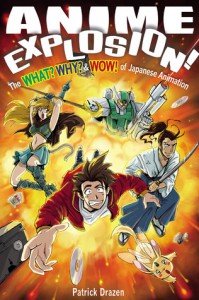
The growth of small presses that focus on specific subject matters like TwoMorrows Publishing for comics and Stone Bridge Press for anime is plenty cause for blogging. Large publishers want the maximum possible audience for every one of their books, which doesn’t fit niche interests like comics and anime (which, although are gaining in popularity, still don’t share the consumer figures of something like baseball or even that most unattended sport, hockey). A small press can be profitable by focusing on these niche areas, by selectively marketing to the established base while making a small amount of their product available to mainstream markets through the larger chain stores and Amazon.
Drazen’s Anime Explosion! has a gosh wow! subtitle, but the actual text, while informal, doesn’t drop to the level of a uncritcal fan. Drazen states from the outset that his goal is to explore the best in anime, and try to help the reader understand where the subject matter came from in the sense of trying to elucidate the Japanese cultural waters. Gilles Poitras mined the same area with The Anime Companion in a dictionary format; Drazen ellaborates on those cultural differences, and while isn’t as comprehensive as Poitras, goes much further in detail by having chapters dedicated to different subject areas (e.g., folktale backgrounds, pornography influence, the Japanese mother).
This book is a nice companion volume to Frederick Schodt’s work on Japanese manga, Dreamland Japan. Given that manga and anime provide two segments of the Japanese entertainment ouroboros (along with video games and, now, trading card games), it proves useful in understanding the themes that tie all of these together: teamwork, the school system, passive religion, birth and rebirth, and war.
An added bonus here is Drazen’s summary of thirteen of both influential and (his) favorite films and directors, including Sailor Moon, Pokemon, Windaria, Escaflowne, and Evangelion. Like another book that I reviewed recently, all this discussion on these make you want to go out and view them, which is difficult as they aren’t the kind of thing you usually find at your local video rental store. (I’m lucky–the Hollywood video here in Tenleytown actually has a huge anime collection, and one of my co-workers is a true anime afficionado.
I picked this book up because of its connections to manga, which I comment often on in my “text and vision” class on comics, and because I’ve been contemplating writing my next novel using the animation industry as the backdrop. Unfortunately, Drazen doesn’t quite get into the behind the scenes of the industry here as much as Schodt does for manga, so I’m still on the lookout for a book that helps me understand how anime get made.
[Finished 12 December 2002]
